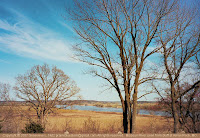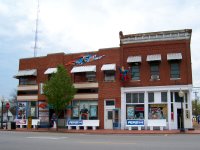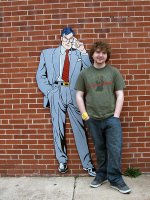Railroads and ferries brought prosperity
 |
| A. B. Safford Memorial Museum in Cairo, Illinois, built in 1883 |
Cairo, Illinois, is at the extreme southern tip of Illinois, at the point where the Ohio and Mississippi Rivers converge.
I always have mixed feelings as I drive through Cairo (pronounced "Care-roh".) Sadly, the town has endured a long period of hard times and population loss. In the business district, empty lots suggest that many deteriorated buildings have been bulldozed and hauled away. Some old buildings, still standing, are candidates for the next demolition list.
 |
| I'm not sure if this church is in use. |
Cairo became an important railroad hub after the Civil War, and the town enjoyed several decades of great prosperity. Train cars (and other vehicles) were ferried across the rivers, and the ferry business was as important to local fortunes as the railroad and river-shipping businesses.
 |
| The Riverlore in Cairo, Illinois |
Then in 1889, the Illinois Central Railroad completed the Cairo Rail Bridge across the Ohio River (image, another image). It was a masterpiece of engineering. The metal bridge itself was nearly 2 miles long and the entire structure including the wooden approaches was almost 4 miles long. Freight from Chicago could travel directly to New Orleans via the Cairo Rail Bridge -- a revolution in rail shipping, but a blow to Cairo.
 |
| More mansions in Cairo |
Vehicles traveling in the Cairo area still used the ferries until two highway bridges were built -- the Mississippi River bridge (leading to Missouri) in 1929, and the Ohio River bridge (leading to Kentucky) in 1937. The bridges and roads connected a short distance south of Cairo, so travelers could quickly cross both rivers without even entering town.
The loss of the railroad and ferry industries was significant, but it alone did not kill the town. By the early 1900s, other serious problems (racism, corruption, violence, crime) were well-established in Cairo. Over the next century, these evils had a slow-but-deadly effect on the town. You can read about the darker side of Cairo's history at "Cairo, Illinois, Death by Racism."
 |
| Overgrowth and disrepair, too! |
Related:
A photo I took inside the Customs House some years ago
Seen at Wickliffe, Kentucky
 |
| Ohio River bridge, just south of Cairo |










































